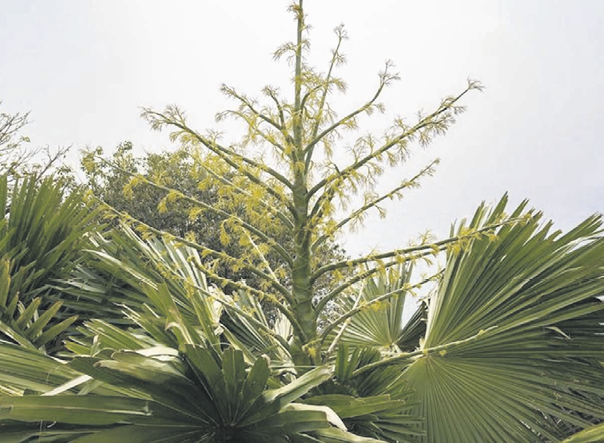
The Palmetum of Santa Cruz de Tenerife enjoys this week the wonderful death of one of its most precious species, the Corypha Umbraculifera, which bids farewell to its existence with one of the most spectacular inflorescences in the world.
According to what the biologist in charge of the park, Carlo Morici, told Efe, it is an “extraordinary” variant because its life cycle consists of being born, developing while producing its trunk, flourishing, bearing fruit and dying. A process similar to that of wheat, agave or banana trees but that, in this case, can take up to 80 years to happen and it does so in a striking way by having a column of flowers that sometimes reaches 8 meters.
“We are, perhaps, before the plant that takes the longest to flower in the world. If you sow the seeds, even as a child, you have no guarantees of seeing it flourish,” the expert said. Morici stressed that this particular specimen has been developed in 25 years due to its proximity to the sea and the wind conditions, which has led it to take less height than usual.
“It surprises us because it is the shortest plant with the largest inflorescence in the world, for us it is lucky because you raise your eyes and you see the structure, it is 3 or 4 meters away, not 20 and that is a spectacle,” he added. the biologist.
Plants that only flower once at the end of their life are called monocarpic or hapaxanthic and, although their farewell may be sad, “it is their way of life,” Morici said. “She laughs at us when she dies, she is happy, she has done what she had to do, you have to accept it and enjoy it, she will also leave millions of seeds that can be planted again,” she commented.
It is not a rare species to find, its origin is located in areas such as India or Thailand and it is common to find them there, what is exceptional is that it flourishes in Europe, since this specimen is the first to die on the continent. “We don’t have much merit because we are an area that allows subtropical, almost tropical cultivation. Specifically, in Santa Cruz the climate is very stable and also in the Palmetum we are surrounded by sea”, he pointed out.
Due to these good conditions, it was decided to plant another two Corypha, as well as two other similar species, adding a total of 10 specimens that carry out the same vital process and that may take 10 or 20 more years to flower.
So that all visitors to the Palmetum can enjoy the experience, the park has made posters and a special path available to the public to get close to the plant. “It has a spectacular part, but it is also an educational event, it is something that is not enough to see it on Wikipedia,” Morici stressed.
Paper
In addition to being one of the favorite plants for botanists, this Corypha has played a relevant role in history since paper was prepared in India from its enormous leaves, up to four meters in diameter, more than six thousand years ago.
“It is possibly the first plant resource used for writing,” Morici said, noting that these practices died with the printing press, but the well-known Palm Leaf Manuscripts were born from the leaves of this species.
















